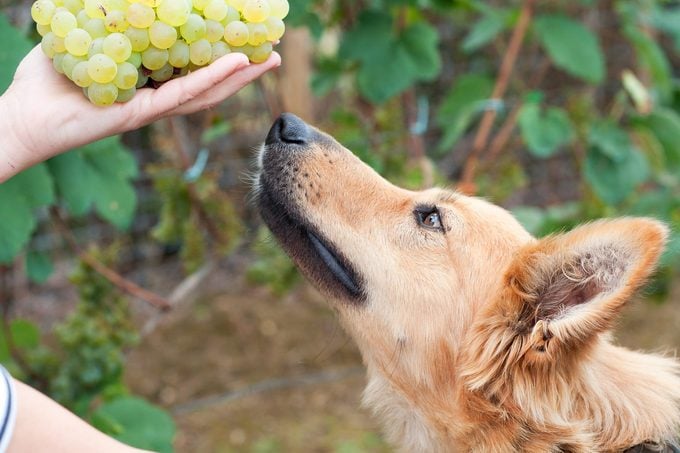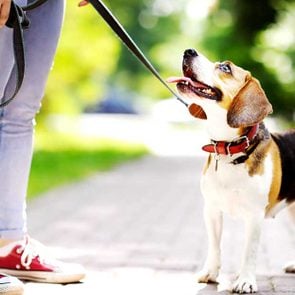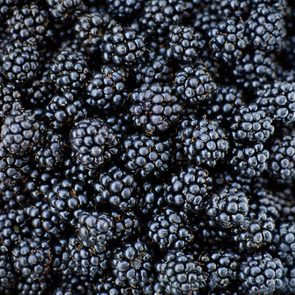Can Dogs Eat Grapes?
Updated: Mar. 08, 2022
Many foods we eat are also safe for dogs in moderation. But can dogs eat grapes?
Is it a good idea to feed dogs grapes?
Grapes are a juicy, bite-sized snack that many people enjoy. Grapes are also low-calorie and rich in nutrients such as potassium and fiber.
Yet researchers and veterinarians know grapes and grape products are toxic to dogs. Although this information dates back more than 20 years, the precise reason for the toxicity remains unknown.
But why can humans eat grapes safely while dogs cannot? How can you tell if your dog is suffering from grape toxicity, and what should you do about it?
Here’s what the experts want you to know about whether dogs can eat grapes, as well as grape toxicity in dogs.
Can dogs eat grapes?
The experts say you should never, under any circumstances, feed a dog grape or grape products because they contain toxins that can cause serious health problems for dogs.
“Grapes and raisins can cause life-threatening kidney disease in some dogs,” says Angela Witzel Rollins, DVM, PhD, a professor of veterinary nutrition at the University of Tennessee.
She says you should always avoid feeding grape and grape products to dogs. The experts add that currants, a type of grapes, are also toxic to dogs.
Why are grapes toxic to dogs?
Again, the American Kennel Club (AKC) says researchers still don’t know precisely what toxin or toxic substance in grapes is harmful to dogs. Still, the experts say some research indicates grapes are probably toxic to dogs because they contain tartaric acid.
“Grapes contain a compound called tartaric acid,” says Tina Wismer, DVM, the senior director of the American Society for the Prevention of Cruelty to Animals (ASPCA) Animal Poison Control Center.
“This is an organic acid, and dogs are the only species that do not excrete these compounds quickly. It is thought that this compound will remain for a period of time in the kidney cells and damage them.”
How many grapes does a dog need to eat for it to be dangerous?
Grapes and grape products are never safe for dogs, regardless of quantity or the dog’s breed, sex, or age. But the size and weight of the dog can influence just how dangerous consuming grapes is for a dog.
“Any more than one grape per 10 pounds of body weight is potentially dangerous,” Wismer says. The AKC says eating even one grape or raisin can potentially be fatal for dogs.
Can dogs eat grape seed extract?
Some research in the Canadian Journal of Veterinary Research suggests grape seed extract may be safe, or even beneficial for dogs, primarily by acting as an antioxidant. Antioxidants protect healthy cells from damage and destruction.
The researchers looked at 11 healthy therapy dogs and gave half an antioxidant supplement containing grape seed extract and other ingredients. Dogs who took the supplement had lower triglycerides and markers of oxidative stress.
But other research in the EFSA Journal found it’s not entirely clear whether grape seed extract is safe for dogs to consume or not. The experts say your safest bet is to stay away from grape seed extract until there’s more information about its potential toxicity to dogs.
Can dogs have grape juice, grape jelly or jam, or other grape products?
The experts say never to give a dog any products that contain grapes or are derived from grapes, including grape juice, grape jellies and jams, and anything grape-flavored.
Aside from containing toxins, grape products often also contain other ingredients that are not good for dogs, such as sugar, preservatives, fat, and artificial sweeteners.
What happens if a dog eats grapes?
According to the AKC, symptoms of grape toxicity often develop within a few hours after a dog eats grapes.
“The first symptoms of grape ingestion include vomiting and lethargy, followed by increased thirst and urination before the kidneys shut down,” Wismer says.
Jennifer A. Larsen, DVM, MS, PhD, a professor of clinical nutrition at the Veterinary Medicine Teaching Hospital, UC Davis in California, adds that grape toxicity can also cause neurological disease in dogs.
Signs of grape toxicity in dogs include:
- reduced appetite
- unusual weakness, lethargy, or stillness
- diarrhea and vomiting
- abdominal pain that is tender upon touch
- reduced or increased urination
- extreme or increased thirst
- dehydration (panting, pale gums, dry mouth and nose or skin that does not immediately spring back after being stretched out)
- difficulty breathing
- lack of consciousness

What to do if a dog eats grapes
If you suspect your dog ate grapes or grape products, contact your veterinarian or the nearest emergency veterinary clinic as soon as possible. You can also contact the ASPCA Animal Poison Control Center for guidance on proceeding by calling 1-888-426-4435.
Try to collect information about what exactly your dog ate, how much, and when, as this can be valuable information that can help determine the best course of treatment for your dog. “The amount actually ingested is critical in determining treatment,” Wismer says.
The experts say to also have information on hand when seeking emergency care for your dog, such as a dog’s weight and their other health conditions.
A veterinarian, veterinary technician, or poison control worker may suggest that you try to force your dog to vomit as soon as possible as long as they are not:
- already vomiting
- having trouble breathing or swallowing
- choking
- very lethargic or weak
- unconscious
- having seizures or being hyperactive
Never induce vomiting in a dog if the dog has consumed sharp or corrosive agents or medications, or has had recent surgery on the abdomen or a swollen or enlarged esophagus. Do not attempt to induce vomiting in a dog without direction from an animal health care professional.
How to induce vomiting in dogs
The experts say to induce vomiting in dogs, try putting your finger down their throat or giving them a small meal if they haven’t eaten for at least two hours.
According to the AKC, if your dog ate grapes within the last two hours, you can also administer one teaspoon per every five pounds of body weight of a 3 percent hydrogen peroxide solution orally to induce vomiting (maximum dose of three tablespoons for dogs weighing more than 45 pounds).
Hydrogen peroxide irritates a dog’s intestinal tract. It tends to cause vomiting within 10 to 15 minutes of administration that may occur for as long as 45 minutes, removing around 50 percent of what your dog ingested.
To administer hydrogen peroxide orally to a dog, use a feeding syringe or turkey baster to squirt the solution into the back of the dog’s mouth or tongue, or between their back teeth, and never let the dog inhale the solution. If the dog doesn’t vomit within 15 minutes of being given a hydrogen peroxide solution, you can give a second dose.
The AKC says to monitor a dog after you have attempted to induce vomiting, and collect any vomit so a veterinarian can examine it. Also, monitor a dog for additional symptoms or adverse reactions, including diarrhea, increased lethargy, bloat, or vomiting that lasts for more than 45 minutes.
Treatment for dogs who eat grapes
Experts and animal health organizations say that in many cases, a veterinarian will try to induce vomiting if a dog has eaten grapes fairly recently, which may involve administering hydrogen peroxide solutions orally.
If initial attempts to induce vomiting in a dog are not successful, or it has been a long time since the dog ingested grapes or raisins, a veterinarian may give them stronger medications to try to remove the toxins.
A veterinarian may also give a dog intravenous (IV) fluids to help restore their electrolyte balance and help “flush out” the toxins from their system faster.
Other foods that are dangerous for dogs
Some foods contain ingredients that can harm dogs because they are toxic to dogs, hard to digest, pose a choking hazard, or can become stuck in the digestive tract and cause impaction (bowel obstruction).
Here are some foods the experts say to avoid feeding to dogs:
- chocolate
- ice cream
- most spices and seasonings
- most nuts, including almonds, macadamia nuts, pecans, and walnuts
- onions, chives, and leeks
- garlic
- bread yeast
- tomatoes
- mushrooms
- alcohol
- caffeine
- citrus fruits
- coconut
- undercooked or raw meat, bones, or eggs
- artificial sweeteners such as xylitol
- salty or sugary snacks and foods
- apple and mustard seeds
- fruit pits, seeds, cores, stones, and peels
- gum
- hops
- moldy foods
- rhubarb leaves
Safe foods to feed dogs
While some foods can pose health complications for dogs, many foods that are safe (and enjoyable!) for you to eat are also safe for dogs. And the experts say giving your dog the occasional human food treat can help diversify their diet, provide excitement and interest, and have nutritional benefits.
According to veterinarians and the AKC, here are some common foods you can feed to your dog in moderation:
- strawberries, blueberries, cranberries, and raspberries
- watermelon and cantaloupe
- yogurt and milk (in very small amounts)
- bread and wheat/grain products
- cooked turkey, chicken, and ham
- cooked eggs
- salmon, shrimp, tuna, and most other fishes and seafood
- popcorn
- unflavored, unseasoned peanuts
- peanut butter
- honey
- eggs
- corn
- cheese
- quinoa and most legumes and pulses (cooked)
- potatoes (cooked and peeled)
- pineapple
- carrots
- broccoli and cauliflower
- kiwi
- cucumbers
- green beans
- canned or cooked pumpkin
- celery
As a word of warning, experts say you should always remove skins, peels, stems, leaves, spikes, pits, cores, and stones from fruits and vegetable foods before feeding them to dogs.
Some vegetables also need to be cooked before being served to dogs for it to be safe, such as potatoes. As a general rule, if you need to cook a type of food before you eat it, it also needs to be cooked before being fed to a dog.
Feedings dogs human foods
Feeding dogs human foods every now and then is usually safe, according to the experts. But they say most of a dog’s diet should consist of foods designed specifically to meet dogs’ nutritional needs, and to try to limit snacks to no more than 10 percent of a dog’s total caloric intake.





















